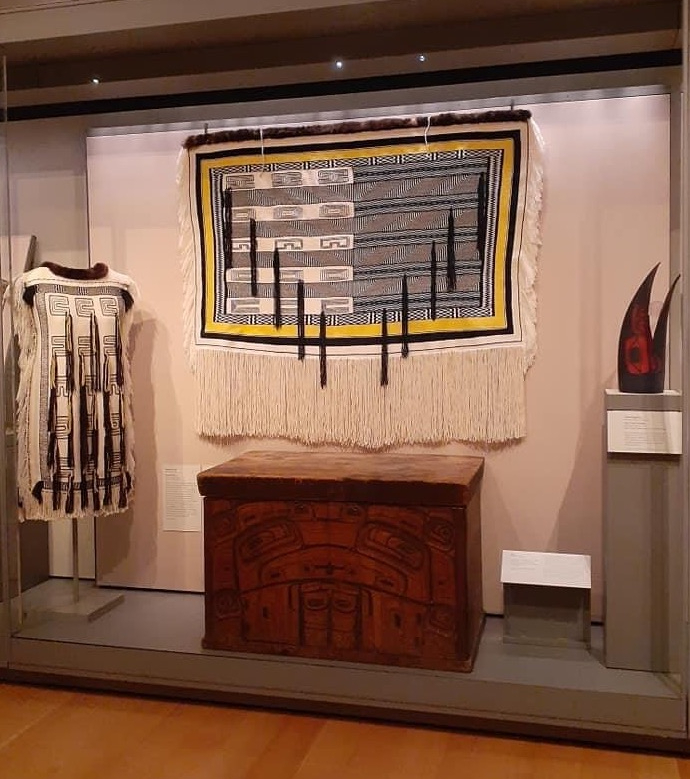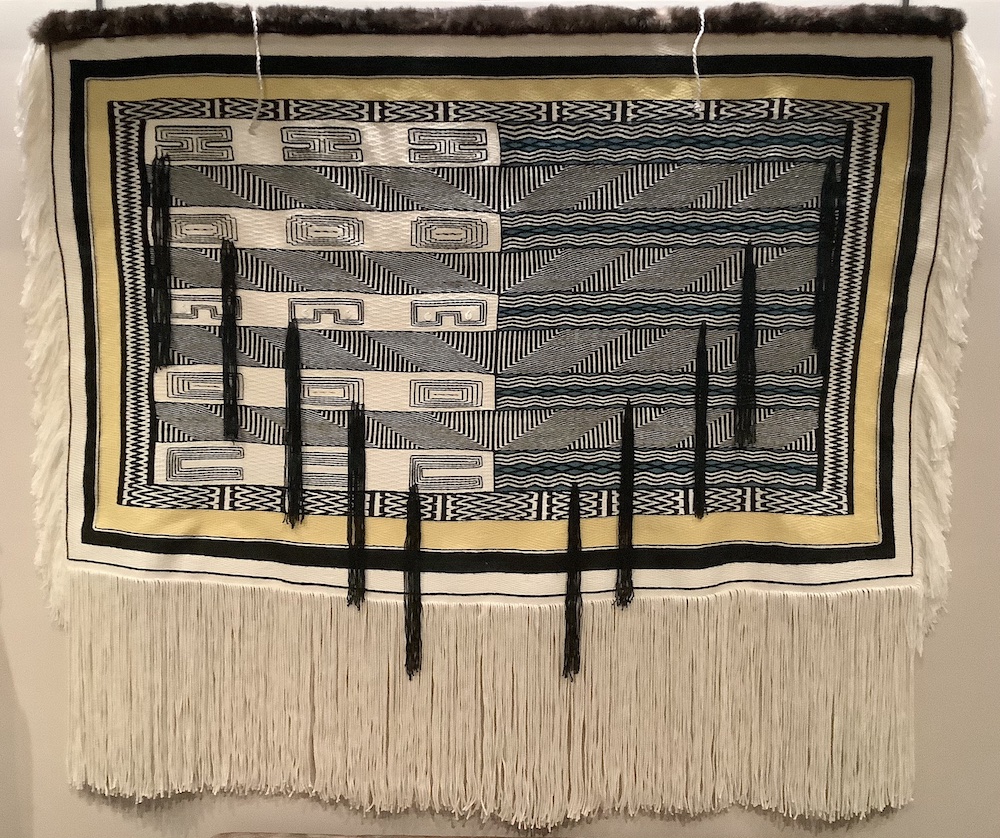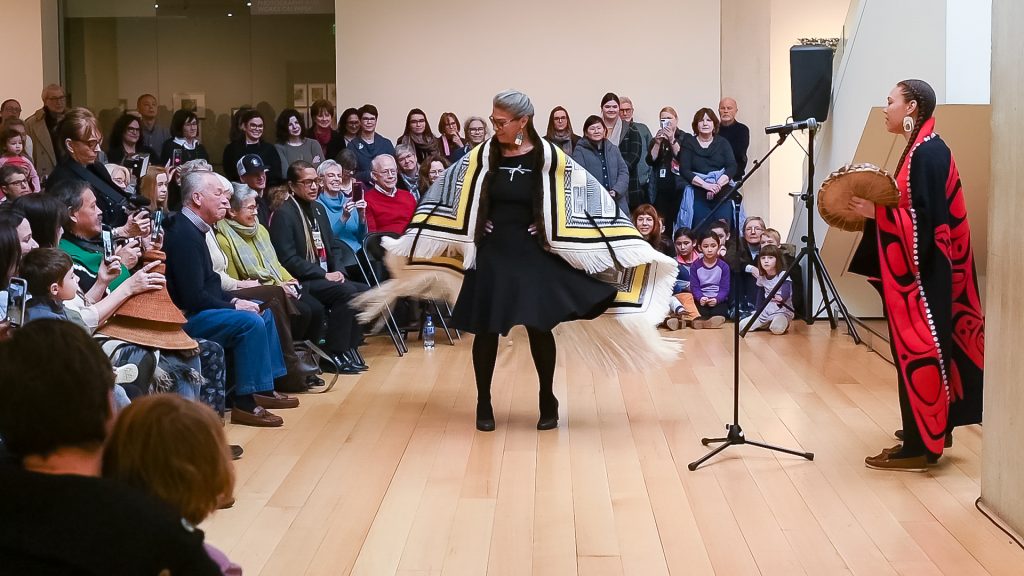
On a recent visit to the MFA, Boston (my first time back since institutional lockdown in March, 2020), I had the great pleasure of standing in front of the commissioned dance robe woven by Evelyn Vanderhoop (Haida name: Kujuuhl) on display in the Native Galleries. This Raven’s Tail “Sky” robe, the first textile made by a living Haida artist to be acquired by the MFA, is shown adjacent to a Raven’s Tail tunic made by her mother, Delores Churchill (Haida name: Ilskyalas), on loan to the MFA from a private collection.
I encourage you to see this exceptional pairing before they come down towards the end of 2021! You can view them in the Native North American Art Gallery (Gallery LG34).


Gazing at the Sky robe in the quiet gallery space with my own reflection in the glass brought on a wave of memories from its celebrated unveiling at the MFA on February 20, 2019. My experience of that day—a rare opportunity to witness the dance of a Native tradition and the animation of a sacred object by its maker—existed in sharp contrast to this most recent encounter of the very same robe installed within its protective glass case. It amplified, beyond measure, my appreciation for having been among those at the public event that Evelyn referred to as “the reveal.”

I follow Evelyn Vanderhoop on social media and saved a beautiful post she shared in February 2020 upon attending an exhibition opening at the Haida Gwaii Museum. Her words resonate with the tension I experienced at my museum visit, between living object and artifact, but reflects her unique perspective. Here’s an excerpt:
In the Gallery, a room full of wishes, the Haida equivalent of C.C. Moore’s poem’s line: “Visions of sugar plums danced in their heads.” About 1,000 photos of objects in other museums around the world graced the walls, objects of utilitarian roles within our ancestors’ culture. All had a purpose within our world when we were closer, intimately tied to our place, our Island home and the watery realms we roamed. We are still here and the world has brought huge changes to our shores. But the changes are just a blink away, a few hundred years. We can see within these objects their purpose, we know their stories, our DNA has not forgotten.
My sense of that missing element between witnessing the dance robe in action, and observing the dance robe on exhibit under glass, sticks with me. I harken back to the direct, intimate encounter of object-based study without barriers that I experienced on a daily basis with countless visitors to our department throughout my time there. It offers a privileged dimension of interaction: inspiring thoughtful conversation about an object’s origin, offering a close reading of the object’s physical structure—in truth, presenting a tangible material link, up close and personal, to people and cultures across time and place.
Evelyn Vanderhoop created her Raven’s Tail robe having had a long-standing connection to the historic “Swift” robe at Harvard University’s Peabody Museum of Archaeology and Ethnology. With assistance from textile conservators there, her opportunity to study the Swift robe and observe its structure up close was a key factor informing her design for the commission.

Evelyn’s collaborator and documentarian Bernadette Jarrard made a video about the making of the Sky robe to educate and enrich our audiences. Here, the fabrication process and meaning behind the geometric patterns and shapes in the Raven’s Tail tradition unfolds. Somewhere, I read Evelyn’s thoughts about these patterns, beautifully articulated by these words:
I think, because there is a rhythm to the patterns, that all patterns may have had a song. Sing the song as you weave and you will make few mistakes. I think dirges and songs were important tools for memory.
Evelyn Vanderhoop continues to be an inspiration to me as she actively creates. During the pandemic, she chose to use her time at the loom as an opportunity to connect with others by telling stories, sharing her knowledge about Haida culture, and teaching about the technique (while graciously mastering her new efforts at digital self-recording). I thoroughly enjoyed watching and listening, journeying along with her as the twined imagery of her worked threads emerged, from row to row. She offers up a true gift with this video series, and I encourage you to take a look! Tune in here to learn about a new work she had started featuring images of copper shields. In this robe, she combines two distinctive Northern Northwest Coast textile techniques: Raven’s Tail (also referred to as Northern Geometric Style) and Naaxin (featuring curvilinear shapes commonly referred to as formline elements).
Evelyn Vanderhoop’s commitment to the research and dissemination of Haida cultural knowledge is a vital aspect of her art practice. She is part of a curatorial team of internationally renown weavers, including her mother Delores Churchill, for the exhibit “The Spirit Wraps Around You: Northern Northwest Coast Native Textiles,” organized by the Alaska State Museum, on view through October 9, 2021. Evelyn and her mother were also included in the groundbreaking exhibition “Hearts of Our People: Native Women Artists,” at the Minneapolis Institute of Art (February 21, 2020–March 13, 2020).
Háw’aa Evelyn and Delores, for your generosity of spirit, your stories and songs, your teaching, and your art!

A Closer Look features in-depth posts that develop from “quick studies” by the author based on Textile and Fashion Arts collections at the MFA, Boston. As such, her deeper explorations share a correspondence with many of the objects she writes about under the category Objects in Brief.
